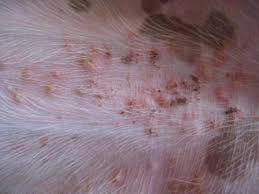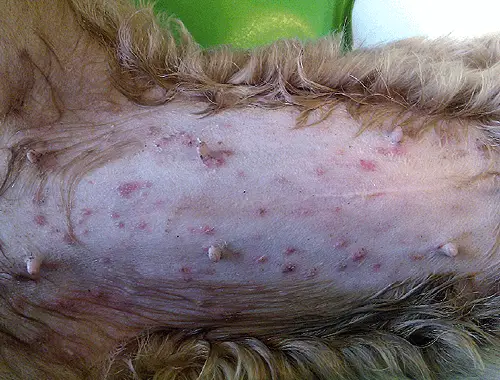Impetigo in Dogs: All You Need To Know
04.03.2022.
Lots of bacteria are living on the dog's skin; nothing strange about that. Dogs that have fully developed immune systems will keep those bacteria under control, and they will not cause additional harm to the dog. On the other hand, puppies are yet to develop their immune system fully, and they are prone to certain health issues. One of that issues is impetigo. Impetigo in dogs is mostly seen in puppies and young dogs, and whenever you notice something strange about your puppy's skin, you should contact your vet and ask for advice.
Here is all you need to know about impetigo in dogs, what are the causes and the symptoms, and what should be the best treatment.
What is impetigo in dogs?
Let’s start with the basics. Impetigo can be best described as pus on the skin. This condition is also called puppy pyoderma, and it basically describes different types of skin infections. It is most commonly associated with Staphylococcus bacteria but is definitely not the only possible cause.
Impetigo can look pretty bad, and dog owners usually get really worried about their puppy’s overall health. This condition is associated with puppies that are usually kept in unhygienic conditions. However, that doesn’t mean puppies are neglected. The good news is that this condition is not contagious, so your other pets are safe. Also, you should know your puppy cannot infect you with impetigo.
What causes impetigo in puppies?
We already briefly mentioned the most common cause of impetigo in dogs - Staphylococcus bacteria overgrowth. This condition is caused by bacteria that already live in the puppy's skin. However, the exact cause of impetigo is not really understood. Vets are not entirely sure why dogs or puppies get it. Nevertheless, they managed to draw some conclusions based on the cases they managed to study. They believe some of these things can play a role in causing impetigo;
- Hormonal imbalance (hypothyroidism, Cushing’s disease)
- Insect bites
- Cuts
- Compromised immune system
- Flea infestation
- Food allergies
- Ringworm
- Mange
Which dogs can get impetigo?
Unfortunately, all dogs can potentially develop impetigo. All breeds have naturally present bacteria living on and in their skin. If something happens to their “natural defenses,” the bacteria can start overproducing, and the dog or a puppy can get impetigo. However, vets noticed certain breeds are responsible for most cases. Those breeds are;
How can I know if my dog has impetigo?
Impetigo is not that hard to miss. Some tell-tell signs can drive you to the conclusion your dog developed this issue. Most dog owners will notice specific impetigo symptoms, which is when they’ll call their vet and book an appointment. The best way to know the dog has impetigo is by getting confirmation from a vet.
Symptoms of impetigo in dogs
Another way to know your dog has impetigo is by learning the most common symptoms and making an educated guess. Your vet will certainly ask you which symptoms you notice in your dog. They will examine those symptoms, which will help them make an accurate diagnosis. Here are the most common symptoms of impetigo in dogs;
- Pustules (small, pus-filled bumps)
- Papules (small red bumps)
- Circular lesions with crusting (epidermal collarettes)
- Lethargy
- Itching
- Hair loss
How is impetigo in dogs diagnosed?
The diagnosis will be based on several things your vet does. The first thing your vet will do is check the dog’s clinical signs and symptoms. That will tell them which tests are needed and where to look first. Here are some of the tests your vet might require;
- Skin cytology - This test will help the vet determine what infected the dog’s skin. It will show any bacterial, fungal, or mite infections.
- Blood tests - can show the dog’s hormonal imbalances and help the vet uncover the cause.
- Allergy tests - Your vet might advise you to switch your dog’s food to hypoallergenic food. The change should last 8 - 12 weeks.
How is impetigo in dogs treated?
The good news is that impetigo is not that difficult to treat. In fact, some cases get resolved on their own without any need for veterinary intervention. However, some cases will require vet assistance. However, most impetigo cases are treated with antibiotics. Your vet might prescribe your dog topical or systemic (oral) broad-spectrum antibiotics. That will get rid of the bacteria causing impetigo and help your dog get rid of the problem.
Recovery of impetigo
Depending on the severity of the infection and your dog's overall health, your vet will find the right treatment so that your dog manages to recover quickly and fully.
For the best recovery, your vet can suggest
- topical treatment to help clear the infection
- oral antibiotics n the more severe cases of impetigo
- keeping the area clean and dry to prevent secondary infections
- Elizabethan collar - if your dog is scratching or licking the affected area
- closely monitoring your dog - so you can quickly react if the condition get worse
Can impetigo be prevented?
The main problem with impetigo prevention is that the exact cause of impetigo is not fully understood. That makes prevention tricky, to say the least. The best thing you can do for your dog or puppy is to make sure they eat high-quality nutrition and live a healthy, active life. Another important thing is to have regular vet visits. Your vet will notice any changes in your dog and make sure the dog is in the best possible shape. Keep your dog safe from parasites and make sure their toys, bedding, and bowls are clean.
World Dog Finder team









Share